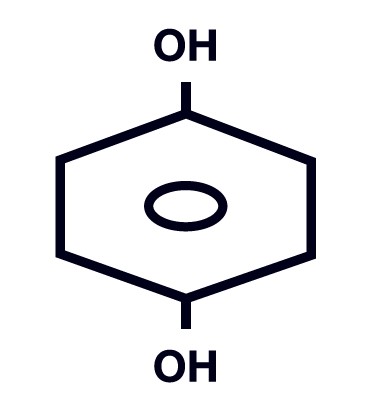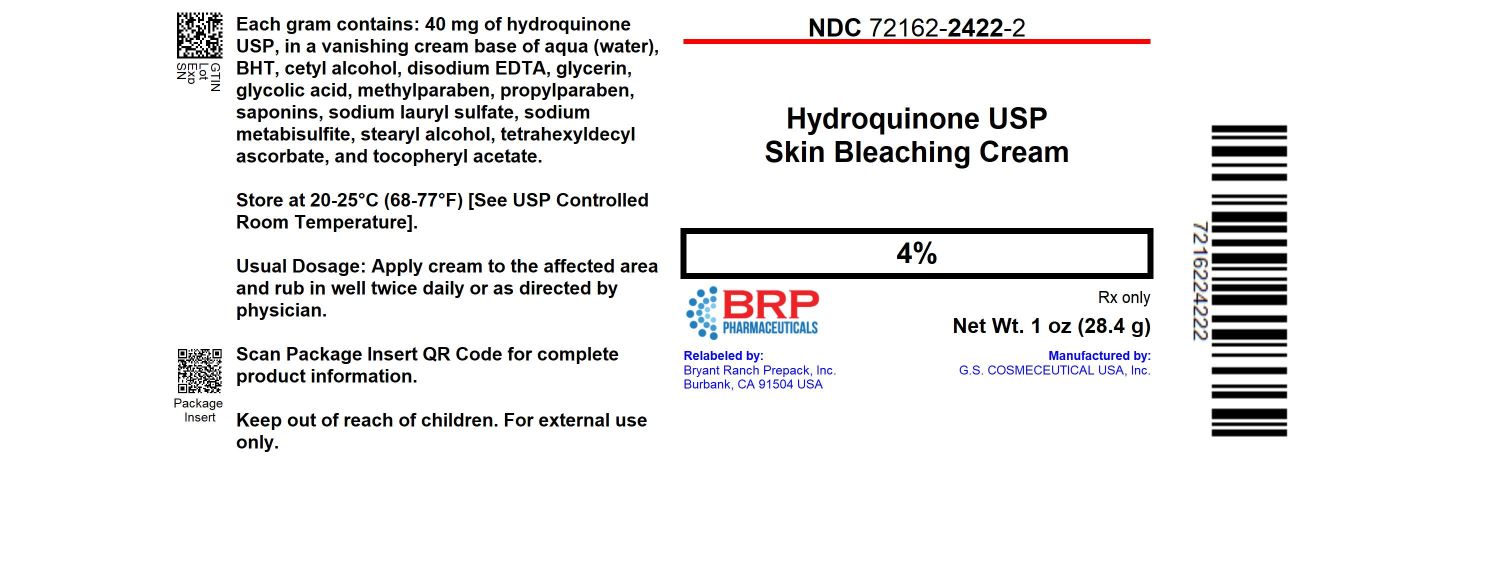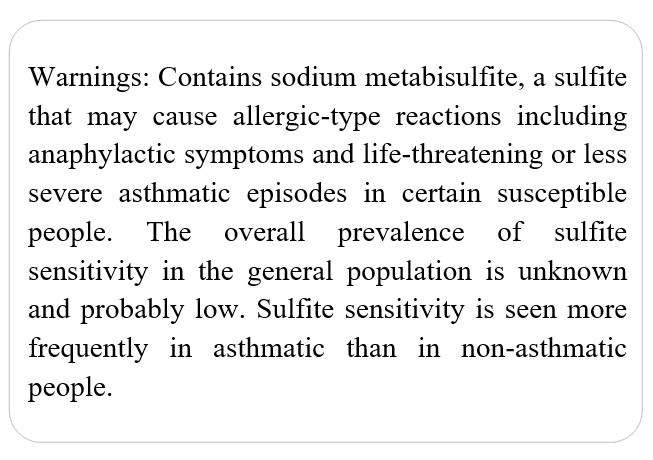Label: HYDROQUINONE 4%- hydroquinone cream
- NDC Code(s): 72162-2422-2
- Packager: Bryant Ranch Prepack
- This is a repackaged label.
- Source NDC Code(s): 75834-137
- Category: HUMAN PRESCRIPTION DRUG LABEL
DISCLAIMER: This drug has not been found by FDA to be safe and effective, and this labeling has not been approved by FDA. For further information about unapproved drugs, click here.
Drug Label Information
Updated November 11, 2024
If you are a healthcare professional or from the pharmaceutical industry please visit this version.
- Download DRUG LABEL INFO: PDF XML
- Official Label (Printer Friendly)
-
DESCRIPTION
Each gram of Hydroquinone USP, 4% Skin Bleaching Cream contains 40 mg of hydroquinone USP, in a vanishing cream base of aqua (water), BHT, cetyl alcohol, disodium EDTA, glycerin, glycolic acid, methylparaben, propylparaben, saponins, sodium lauryl sulfate, sodium metabisulfite, stearyl alcohol, tetrahexyldecyl ascorbate, and tocopheryl acetate. Chemically, hydroquinone is C6H6O2 and has a molecular weight of 110.11. The chemical name is 1,4 dihydroxybenzene, and the structural formula of hydroquinone is:

-
CLINICAL PHARMACOLOGY
Topical application of hydroquinone produces a reversible depigmentation of the skin by inhibition of the enzymatic oxidation of tyrosine to 3,4-dihydroxyphenylalanine (dopa) (Denton, C. et al., 1952)1 and suppression of other melanocyte metabolic processes (Jimbow, K. et al., 1974)2. Exposure to sunlight or ultraviolet light will cause repigmentation of bleached areas (Parrish, J.A. et al., 1978)3.
- INDICATIONS & USAGE
- CONTRAINDICATIONS
-
WARNINGS
Contains sodium metabisulfite, a sulfite that may cause allergic-type reactions including anaphylactic symptoms and life-threatening or less severe asthmatic episodes in certain susceptible people. The overall prevalence of sulfite sensitivity in the general population is unknown and probably low. Sulfite sensitivity is seen more frequently in asthmatic than in non-asthmatic people. Since this product contains no sunscreen, an effective broad spectrum sun blocking agent should be used and unnecessary solar exposure avoided, or protective clothing should be worn to cover bleached skin in order to prevent repigmentation from occurring. Hydroquinone may produce exogenous ochronosis, a gradual blue-black darkening of the skin. If this condition occurs, discontinue treatment and consult your physician. The majority of patients developing this condition are Black, but it may also occur in Caucasians and Hispanics.
-
PRECAUTIONS
(see WARNINGS)
GENERAL PRECAUTIONS
Test for skin sensitivity before using by applying a small amount to an unbroken patch of skin; check within 24 hours. Minor redness is not a contraindication, but where there is itching or vesicle formation or excessive inflammatory response further treatment is not advised. Close patient supervision is recommended.
Hydroquinone is a skin bleaching agent which may produce unwanted cosmetic effects if not used as directed. The physician should be familiar with the contents of this insert before prescribing or dispensing this medication.
INFORMATION FOR PATIENTS
Sunscreen use is an essential aspect of hydroquinone therapy because even minimal sunlight sustains melanocytic activity. To prevent repigmentation, during treatment and maintenance therapy, sun exposure on treated skin should be avoided by application of a broad spectrum sunscreen (SPF 15 or greater) or by use of protective clothing.
Avoid contact with eyes and mucous membranes.
Keep this and all medications out of reach of children. In case of accidental ingestion, call a physician or a poison control center immediately.
DRUG INTERACTIONS
Patients are cautioned on concomitant use of medications that are known to be photosensitizing.
CARCINOGENESIS & MUTAGENESIS & IMPAIRMENT OF FERTILITY
Studies of hydroquinone in animals have demonstrated some evidence of carcinogenicity. The carcinogenic potential of hydroquinone in humans is unknown.
Published studies have demonstrated that hydroquinone is a mutagen and a clastogen. Treatment with hydroquinone has resulted in positive findings for genetic toxicity in the Ames assay in bacterial strains sensitive to oxidizing mutagens, in in vitro studies in mammalian cells, and in the in vivo mouse micronucleus assay.
PREGNANCY
Teratogenic Effects: Pregnancy Category C -
Animal reproduction studies have not been conducted with topical hydroquinone. It is also not known whether topical hydroquinone can cause fetal harm when administered to a pregnant woman or can affect reproduction capacity. Topical hydroquinone should be given to a pregnant woman only if clearly needed. -
ADVERSE REACTIONS
The following adverse reactions have been reported: dryness and fissuring of paranasal and infraorbital areas, erythema, and stinging.
Occasional hypersensitivity (localized contact dermatitis) may develop. If this occurs, the medication should be discontinued and the physician notified immediately.
- OVERDOSAGE
-
DOSAGE & ADMINISTRATION
Hydroquinone USP, 4% Skin Bleaching Cream should be applied to affected areas and rubbed in well twice daily, in the morning and before bedtime, or as directed by a physician. If no improvement is seen after 2 months of treatment, use of this product should be discontinued. There is no recommended dosage for pediatric patients under 12 years of age except under the advice and supervision of a physician.
-
HOW SUPPLIED
Hydroquinone USP, 4% Skin Bleaching Cream is available as follows:
NDC: 72162-2422-2: 1 oz (28.4 g) in a tube.
STORAGE
Hydroquinone USP, 4% Skin Bleaching Cream should be stored at controlled room temperature (20-25°C) (68-77°F). Darkening of this product is normal.
This will not affect performance or safety.Repackaged/Relabeled by:
Bryant Ranch Prepack, Inc.
Burbank, CA 91504 - PRINCIPAL DISPLAY PANEL
-
INGREDIENTS AND APPEARANCE
HYDROQUINONE 4%
hydroquinone creamProduct Information Product Type HUMAN PRESCRIPTION DRUG Item Code (Source) NDC:72162-2422(NDC:75834-137) Route of Administration TOPICAL Active Ingredient/Active Moiety Ingredient Name Basis of Strength Strength HYDROQUINONE (UNII: XV74C1N1AE) (HYDROQUINONE - UNII:XV74C1N1AE) HYDROQUINONE 40 mg in 1 g Inactive Ingredients Ingredient Name Strength WATER (UNII: 059QF0KO0R) BUTYLATED HYDROXYTOLUENE (UNII: 1P9D0Z171K) CETYL ALCOHOL (UNII: 936JST6JCN) GLYCERIN (UNII: PDC6A3C0OX) GLYCOLIC ACID (UNII: 0WT12SX38S) METHYLPARABEN (UNII: A2I8C7HI9T) PROPYLPARABEN (UNII: Z8IX2SC1OH) SODIUM LAURYL SULFATE (UNII: 368GB5141J) SODIUM METABISULFITE (UNII: 4VON5FNS3C) STEARYL ALCOHOL (UNII: 2KR89I4H1Y) TETRAHEXYLDECYL ASCORBATE (UNII: 9LBV3F07AZ) .ALPHA.-TOCOPHEROL ACETATE, DL- (UNII: WR1WPI7EW8) EDETATE DISODIUM (UNII: 7FLD91C86K) Packaging # Item Code Package Description Marketing Start Date Marketing End Date 1 NDC:72162-2422-2 1 in 1 CARTON 11/11/2024 1 28.4 g in 1 TUBE; Type 0: Not a Combination Product Marketing Information Marketing Category Application Number or Monograph Citation Marketing Start Date Marketing End Date UNAPPROVED DRUG OTHER 08/17/2022 Labeler - Bryant Ranch Prepack (171714327) Registrant - Bryant Ranch Prepack (171714327) Establishment Name Address ID/FEI Business Operations Bryant Ranch Prepack 171714327 REPACK(72162-2422) , RELABEL(72162-2422)




